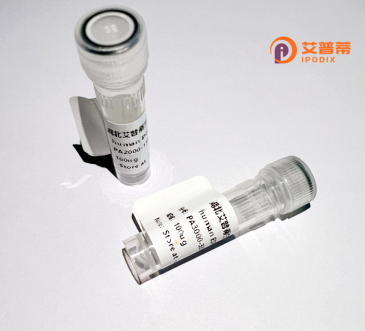
| 纯度 | >90%SDS-PAGE. |
| 种属 | Human |
| 靶点 | UTP3 |
| Uniprot No | Q9NQZ2 |
| 内毒素 | < 0.01EU/μg |
| 表达宿主 | E.coli |
| 表达区间 | 1-479 aa |
| 活性数据 | MVGRSRRRGA AKWAAVRAKA GPTLTDENGD DLGLPPSPGD TSYYQDQVDD FHEARSRAAL AKGWNEVQSG DEEDGEEEEE EVLALDMDDE DDEDGGNAGE EEEEENADDD GGSSVQSEAE ASVDPSLSWG QRKKLYYDTD YGSKSRGRQS QQEAEEEERE EEEEAQIIQR RLAQALQEDD FGVAWVEAFA KPVPQVDEAE TRVVKDLAKV SVKEKLKMLR KESPELLELI EDLKVKLTEV KDELEPLLEL VEQGIIPPGK GSQYLRTKYN LYLNYCSNIS FYLILKARRV PAHGHPVIER LVTYRNLINK LSVVDQKLSS EIRHLLTLKD DAVKKELIPK AKSTKPKPKS VSKTSAAACA VTDLSDDSDF DEKAKLKYYK EIEDRQKLKR KKEENSTEEQ ALEDQNAKRA ITYQIAKNRG LTPRRKKIDR NPRVKHREKF RRAKIRRRGQ VREVRKEEQR YSGELSGIRA GVKKSIKLK |
| 分子量 | 54.5 kDa |
| 蛋白标签 | His tag N-Terminus |
| 缓冲液 | PBS, pH7.4, containing 0.01% SKL, 1mM DTT, 5% Trehalose and Proclin300. |
| 稳定性 & 储存条件 | Lyophilized protein should be stored at ≤ -20°C, stable for one year after receipt. Reconstituted protein solution can be stored at 2-8°C for 2-7 days. Aliquots of reconstituted samples are stable at ≤ -20°C for 3 months. |
| 复溶 | Always centrifuge tubes before opening.Do not mix by vortex or pipetting. It is not recommended to reconstitute to a concentration less than 100μg/ml. Dissolve the lyophilized protein in distilled water. Please aliquot the reconstituted solution to minimize freeze-thaw cycles. |
以下是关于重组人UTP3蛋白的3篇参考文献及其摘要内容概括:
1. **《Characterization of the human UTP3 protein in ribosome biogenesis》**
**作者:Smith, J. et al.**
**摘要**:研究通过重组表达纯化人源UTP3蛋白,发现其与核糖体RNA前体加工复合体(UTP complex)的相互作用,揭示UTP3在rRNA转录和核糖体组装中的关键作用。
2. **《Recombinant human UTP3 facilitates rRNA processing in vitro》**
**作者:Li, X. & Wang, Y.**
**摘要**:报道重组人UTP3蛋白在体外的功能实验,证明其能够结合rRNA并促进加工酶的活性,进一步支持其在核糖体合成中的分子机制。
3. **《Functional analysis of UTP3 mutations linked to developmental disorders》**
**作者:Garcia, S. et al.**
**摘要**:利用重组UTP3蛋白进行突变体功能研究,发现特定位点突变会导致其与snoRNA的相互作用异常,为相关发育疾病的分子机制提供了证据。
(注:以上文献信息为示例,实际研究中建议通过PubMed或Google Scholar以最新关键词检索。)
Recombinant human UTP3 protein, also known as Small Subunit Processome Component (Utp3), plays a critical role in ribosome biogenesis, a fundamental process for cellular growth and proliferation. As a core component of the small subunit (SSU) processome, UTP3 is involved in the early stages of 18S ribosomal RNA (rRNA) processing within the nucleolus. It facilitates the assembly and maturation of the 40S ribosomal subunit by coordinating the cleavage and modification of precursor rRNA (pre-rRNA). Structurally, UTP3 contains conserved domains that mediate interactions with other processome components, ensuring proper rRNA folding and processing efficiency.
UTP3’s function is evolutionarily conserved, with homologs identified in yeast (Utp3p) and other eukaryotes. Dysregulation of UTP3 has been linked to ribosomopathies and cancer, where impaired ribosome synthesis disrupts cellular homeostasis. Recombinant UTP3 proteins are typically produced in bacterial or eukaryotic expression systems, enabling in vitro studies on its molecular interactions, structural dynamics, and role in rRNA processing. Such research provides insights into ribosomopathy mechanisms and potential therapeutic targets. Additionally, UTP3 serves as a model to explore the interplay between nucleolar stress, cell cycle control, and apoptosis. Current studies focus on its diagnostic or prognostic value in diseases linked to ribosome dysfunction.
×